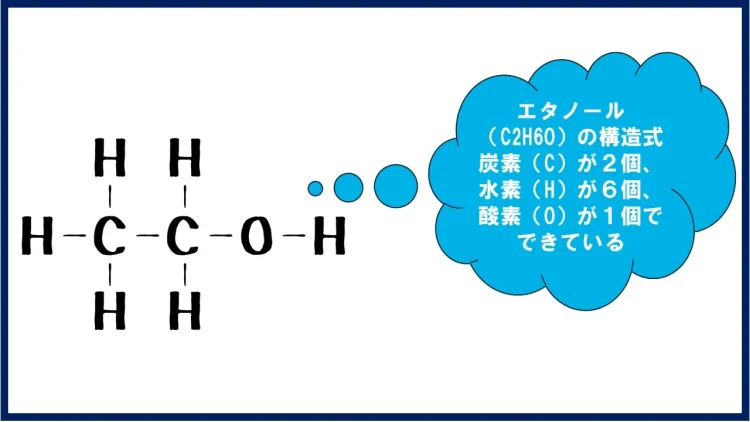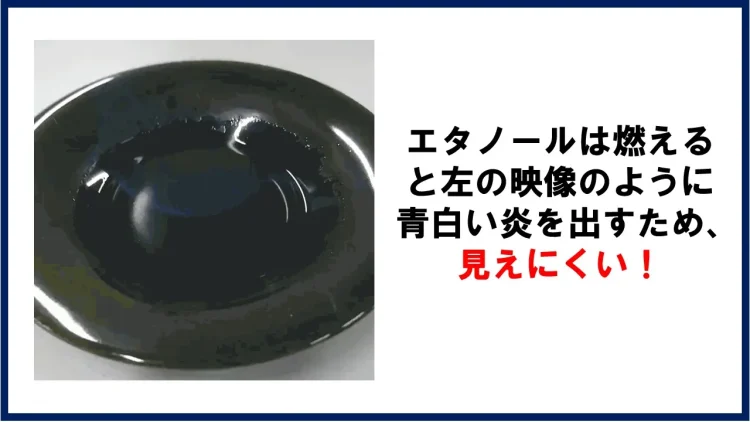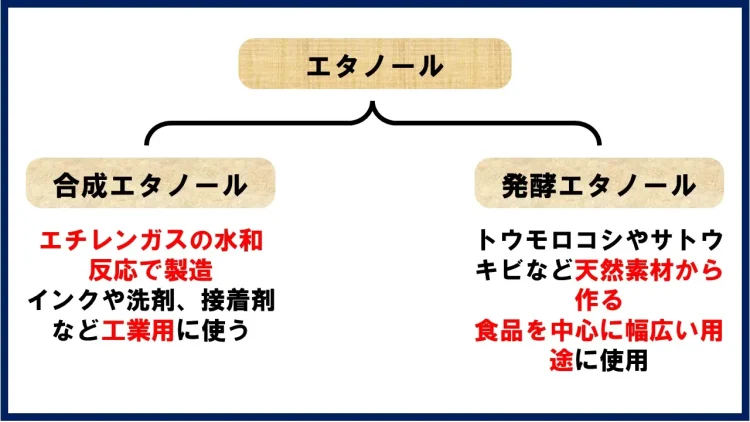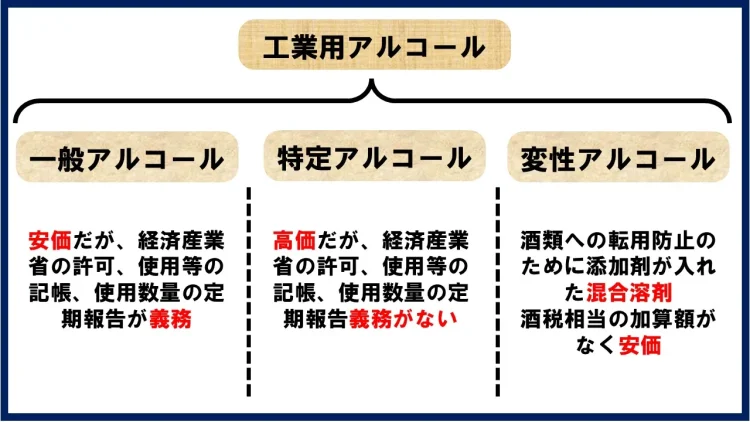お知らせ・お役立ち便覧 NEWS
有機溶剤 身近な有機溶剤
2025.04.30
エタノールとは?工業用と飲用の違い、成分などについてわかりやすく解説

お酒や消毒液の成分として知られるエタノールについて、その成分や特徴などを中心にわかりやすく解説します。
目次
エタノールとは?
エタノールとは、アルコールのひとつで、エチルアルコールや酒精とも呼ばれています。
お酒や消毒液の成分として身近な存在であり、工業用としても使われる有機溶剤でもあります。
※有機溶剤については、「有機溶剤とは?わかりやすく解説します」で丁寧に解説しています。
 化学式はC2H6Oで、炭素(C)2個、水素(H)6個、酸素(O)1個から成ります。
化学式はC2H6Oで、炭素(C)2個、水素(H)6個、酸素(O)1個から成ります。
エタノールの特徴を以下の表にまとめました。
| 項目 | 概要 |
| 名称 | エタノール |
| 別称 | エチルアルコール、酒精 |
| CAS番号 | 64-17-5 |
| 化学式 | C2H6O |
| 引火点 | 12.8℃ |
| 発火点 | 363℃ |
| 沸点 | 78.3℃ |
| 比重 | 0.795 |
| 有機溶剤中毒予防規則 | 非該当 |
| PRTR法 | 非該当 |
表の通り、引火点(火を近づけたときに燃え始める最低温度)が12.8℃と大変低く、燃えやすく火気には注意が必要で、消防法でも規制されています。
 エタノールが燃えるときは、ろうそくや木と異なり青色の暗い炎を出します。そのため見えづらく、燃えていることに気が付かなかったり、消したと思っても消えていなかったりすることがあるため注意が必要です。
エタノールが燃えるときは、ろうそくや木と異なり青色の暗い炎を出します。そのため見えづらく、燃えていることに気が付かなかったり、消したと思っても消えていなかったりすることがあるため注意が必要です。
消防法による規制
エタノールは消防法では、第4類アルコール類に分類されます。
消防法の規制を受けずに保管できる量である指定数量は400Lです。
また、危険物倉庫がなくても保管できる少量危険物(指定数量の1/5)は80Lです。
詳しい規制の内容は、別記事「消防法とは?該当する有機溶剤、指定数量の考え方などもわかりやすく解説」で詳しく説明しておりますので、併せてご覧ください。
アルコールとは
アルコールとは、化学的には炭化水素類の水素を水酸基(-OH)で置換した構造の化合物の総称です。
代表的なアルコールとしては、エタノールの他にIPA(イソプロピルアルコール)やメタノール、ブタノール、イソブチルアルコールなどがあります。
一般的に生活する中で「アルコール」というとお酒のことを指しますが、それだけではないということです。
お酒の主成分はアルコールはエタノール(エチルアルコール)です。
エタノールの分類
エタノールの分類としては、製造方法によるものと法令によるものがあります。
製造方法による分類
 エタノールは製造方法により、合成エタノールと発酵エタノールの2つに分けられます。
エタノールは製造方法により、合成エタノールと発酵エタノールの2つに分けられます。
| 製造方法 | 主な用途 | |
| 合成エタノール | エチレンを原料に水を付加して化学的に合成 | インク、塗料、接着剤、化粧品などの工業用に使用 |
| 発酵エタノール | サトウキビやトウモロコシ、米など天然の原料を発酵させて作る | 食品の防腐剤、調味料、酒など飲料や食品を中心に広範に使用 |
合成エタノール
合成エタノールは、エチレンガスの水和反応によって製造します。
インクや塗料、接着剤、農薬、化粧品、洗剤など主に工業用に使い、食品には使えません。
発酵エタノール
発酵エタノールは、サトウキビやトウモロコシ、米などの天然の原料に、これらを糖化・発酵させて作ります。
酒や、調味料、食品の防腐剤、飲料や食品を中心に幅広い用途で使います。※工業用にも使います
法令による分類
エタノールは、純度や製造方法、性質によって、飲用や医薬用、工業用に分類し、適用する法令が異なります。
| 分類 | 適用法令 | 所管省庁 |
| 工業用 | アルコール事業法 | 経済産業省 |
| 飲用 | 酒税法 | 財務省 |
| 医薬用 | 薬事法 | 厚生労働省 |
エタノールは、燃えやすく火災の危険があるため上記の法令とは別に消防法で規制されています。
消防法については、別記事「消防法とは?該当する有機溶剤、指定数量の考え方などもわかりやすく解説」で丁寧に説明しておりますのでぜひお読みください。
工業用アルコールとは?
アルコール事業法が適用される工業用アルコールは、エタノールを90度(90vol%)以上を含みます。
工業用アルコールには、一般アルコールと特定アルコール、変性アルコールの3種類があります。
一般アルコール
一般アルコールは、お酒への不正使用を防止するための酒税相当の加算額(以下、加算額)を含まない安価なエタノールです。
ただし、使用にあたり事前に経済産業省の許可が必要で、使用等の記帳や使用数量の定期報告が義務付けられています。
特定アルコール
特定アルコールは、加算額を含むエタノールです。
事前許可や記帳、数量の定期報告は不要ですが、一般アルコールと比べ高価です。
変性アルコール
変性アルコールは、加算額を避けて安価にするために、エタノールに酒類への不正使用を防止するため添加剤を加えた混合溶剤です。基本的にエタノール分は90%以下です。
三協化学のエタノール関連製品
弊社のエタノール関連の商品には以下のようなものがあります。
| 製品名 | 分類 |
| エタノール(未変性) | 一般アルコール |
| 高濃度エタノール製剤 IPA代替 エタコール7 | 変性アルコール |
| 無水エタノール同等 エタノール濃度99.5wt% 電子部品洗浄剤F-1 | |
| 皮膚等障害物質(皮膚障害化学物質)非該当 変性アルコール エタコール3 | |
| トレーサブル99 | 特定アルコール |
その他、エタノールに関して疑問、ご質問は以下リンクよりお問い合わせください。
エタノールに関する質問
※2024年11月19日更新
以前、ページのコメントに寄せられた疑問・質問とその回答をご紹介します。
(※一部編集・抜粋しております)
質問No.01~10
※「▼」をクリックすると質問が表示されます。
エタノールやアルコールにプラモデル用接着剤は溶けますか?
エタノールをはじめとするアルコールは、接着剤自体にも、接着後の接着面も溶けません。
貴社製品のエタコール7について、使用すると劣化させてしまう樹脂や素材はありますか?
また、アクリルやABSへの影響はIPAやメタノールと比較するとどうでしょうか?
アクリル樹脂はクラックが入ってしまうので、ご使用いただけません。(クラックを入れるために使用するケースはございます)
ABSもアクリルが入っているため、長時間触れさせると膨潤するおそれがあります。
また、スチレンやポリアミドも推奨はしきれません。
ただエタコール7は弊社内でも、樹脂やゴムなどで多く試験しておりますが影響はかなり少ない部類にはいります。また、エタコール7もIPA、メタノールと同じアルコール系の洗浄剤でございますゆえ、影響は同等でございます。
ただ、有機溶剤中毒予防規則や女性則に該当しない製品でございます故、人体への影響はIPAやメタノールと比較すると安全性は高くなります。
御社取り扱いのエタノールは、合成エタノールと発酵エタノールどちらになりますでしょうか?
弊社のエタコール7と電子部品用洗浄剤F-1に使われているエタノールは合成エタノールです。
電子部品用洗浄剤F-1を消毒液の代わりになるからと、薦められ購入しましたが、手、指、ドアノブや家具類などといった部分に使えると言ってみえました。
小さい子供もおり、本当に使っても大丈夫なのでしょうか?
あくまでも自己責任でとは言ってますが。
自分が勤めている会社の取引先の業者さんから、今、コロナウイルスで世間が騒いでいるからと言って、薦められ購入しました。
工業用とは言っても、他の医療用の消毒液と何ら変わりないというのなら、使いたいと思っています。正直な所、どうなのでしょうか?
電子部品用洗浄剤F-1は消毒用として用いていただくことができません。(下記リンク参照)
弊社アルコール系溶剤の除菌・消毒効果についてまた、電子部品用洗浄剤F-1は飲用ができないようにしてあるため酒税がかからないようになっているのですが、この飲用できなくなるしくみ、というのが配合されている「安息香酸デナトニウム」です。
こちらの成分、よく幼児がおもちゃを誤飲しないようにおもちゃがとても苦くなるように配合されている成分と同じものです。
安息香酸デナトニウムは不揮発成分のため、エタノールが乾いた後も、塗布面に残ります。(ごく微量で肉眼では確認できませんが、それでもとても苦みを発揮します)
そのため、手に塗布した後お食事をされたりするとその成分がお口にはいり、非常に苦い思いをされてしまいます。手に触れる部分の使用はお勧めできません。また、あくまで弊社製品は工業用途で開発製造しておりますので、通常ゴム手袋やゴーグル、マスクなどを着用して使用していただく製品でございますし、医療用ではございませんので、医薬品のように薬剤師が管理していない、製造工程に関する検査や製品の検査は自社独自によるものでございますので消毒用のエタノール製剤とは異なるものです。ご注意くださいませ。
指、手等コロナ菌が完全に消えるのはアルコール 何パーセント以上でしょうか?
パーセンテージが同じでも、塗布方法や環境、塗布時間によって濃度が異なりますので「この濃度を塗布すれば問題ありません。」とは申し上げることはできませんが、最も効果を発揮するのは70~80%とされています。
工業用エタノールはコロナウイルスに有効ですか?
弊社工業用エタノールは、コロナウイルスに対してのエビデンスをとっていないため、有効と申し上げることはできないうえ、手指にもお使いいただくことはできません。
メーカーごとに検査項目が異なりますので、メーカー様へご確認ください。
第四類第三石油類の引火点130-140℃水溶性の商品をBtoB及びBtoCへ配送をしたいのですが、宅配便で配送を考えています。問題ありますでしょうか。
また、チャーターの想定もございますが注意点などございますでしょうか。
おそらく大丈夫かとは思いますが、運送会社ごとの約款にもよって変わってきてしまいます。
お手数ですが、運送会社様にご確認ください。
チャーターの注意点といたしましては、指定数量が4000Lとなりますので、もし4000L以上運送する場合、トラックに「危」のマークを付けなければなりませんのでご注意ください。
特定アルコールトレーサブル99 1級という商品をもらったのですがコロナ対策での消毒に効くのでしょうか?
手指消毒や噴霧して消毒液としてしようできるのでしょうか?
特定アルコールは消毒用アルコールではございませんので、手指に使用可能か、またウイルスへの効果に関してメーカー様へ一度ご確認ください。
エタノールについて、質問です。
(1)電子部品用洗浄剤F-1には、メタノール成分は入っていないですか?合成エタノールと添加物のみですか?
(2)変性エタノールとはなにですか?
(3)合成エタノールと植物由来のエタノールとは、物性など違いはありますか?
(1)電子部品用洗浄剤F-1にはメタノールは入っていません。合成エタノールと添加物(苦み剤)のみです。
(2)変性エタノールとは、アルコール事業法のエタノールに対し、飲用できないよう処理を行ったエタノールのことです。
(3)エタノールとしては同じですが、使用される分野が異なる場合があります(食品添加物用のエタノールは植物由来でないとなることはできません)
14日厚生労働省は工業用エタノールを手指の消毒に代用できるという事務連絡を都道府県に通知しました。電子部品洗浄剤F-1を手指消毒用に代用したいと思っています。
エビデンスがないのは情緒済みです。効果は期待できますでしょうか。
そちらの情報は共同通信様が4月14日に出された記事でしょうか?
そちらの内容でしたら、厚生労働省が3月23日日付で出した内容になり、病院や介護施設などがやむを得ない場合に限り、使用者の責任において使用できるよう通達した文書で、一般の方に関してはこちらの中には含まれておりません。また、弊社電子部品用洗浄剤F-1には安息香酸デナトニウムが含まれており、手指にお使いいただいた場合、安息香酸デナトニウムが不揮発成分として手指に残渣し、それが口に入った際猛烈な苦みを感じるおそれがあります。
こちらは通常ゴム手袋などの保護具着用の元ご使用いただくものですので、手指への塗布はお避け下さい。
質問No.11~20
※「▼」をクリックすると質問が表示されます。
消毒用アルコールについて検索していたところ、こちらへ辿り着きました。
この度、ネット通販にて消毒用ハンドジェルの購入を考えているのですが、その商品には「エタノール配合 ※溶剤」と表記されております。
わざわざ「※溶剤」と表記されていることがどうしても気になってしまうのですが、こちらは手指の消毒として使用しても問題ないのでしょうか
何故それをあえて表記したのか、申し訳ありませんがそれは弊社ではわかりません。
メーカー様へお問い合わせいただけないでしょうか。
一応ハンドジェルとして販売なさっているのならば、ハンドにお使いいただくために製造していらっしゃらないといけないですが…
職場(医療介護には無関係です)に特定アルコール一斗缶の斡旋案内が来ました。1:4で希釈して手指消毒用に使えるとありました。
一斗缶からハンドスプレー用の容器には簡単に移せるはずがないのと、保管方法に制限があるのでは無いかと考えています。
希釈時、保管の注意事項などを教えていただけないでしょうか。
特定アルコールを検索していてこちらに辿り着きました。貴社製品外の質問になってしまい申し訳ありません。
アクリル容器はご遠慮いただきたいのですが、その他樹脂容器、ガラス製、金属製容器でしたら問題ありません。
できればポリエチレンでお願いいたします。
保管時はしっかり密閉し、日の当たらない涼しい、風通しの良いところで保管ください。
また火気にはくれぐれも気を付けて、なるべくお早めに使い切りください。
「エタノール配合※溶剤」と書かれたハンドジェルを購入してしまいました。
70%と書かれていたので安心していたのですが、、この【溶剤】という部分が、かなり小さく表記されていたのに後から気付きました。
これは、コロナには効果なしでしょうか。
エタノールはもともと有機溶剤の一種ですので、エタノールとエタノール(溶剤)は違うというわけではありませんが、飲用のアルコールではないよ、ということを表記されたかったのでしょうか?
濃度や、ハンドジェルという性質上、効果は一定あるかと思いますが、そちらの製品を弊社で製造販売したり、分析したことがないので、メーカー様へご確認いただくのが一番です。
電子部品用洗浄剤F-1は水道水にてエタノール濃度を80%に薄めた場合、水道水保管用のポリ容器(10リッター)に保管しても問題ありませんか?
危険物のため、消防法上、樹脂容器で保管する際は1容器10Lまでと定められておりますが、ギリギリ問題ありません。
なるべく小分けにして保管いただくことをお勧め致します。
また、しっかり密閉して火の気のないところ+日の当たらない涼しく換気が行き届くところで保管ください。
電子部品用洗浄剤F-1を精製水にてエタノール濃度を80%に薄めたものでドアの取っ手やまな板などの消毒に利用した際、手が濡れたらすぐ水洗いをすれば問題ありませんか?
弊社電子部品用洗浄剤F-1をドアの取っ手やまな板に塗布なさると、不揮発成分の「安息香酸デナトニウム」が残り、こちら非常に微量ではありますが劇的な苦みを感じる成分のため、お料理の味が非常に苦くなってしまいます。
(子供用玩具を子供が誤飲しないよう含まれている苦み剤成分と同じもので、これを配合することにより飲用できないアルコールとして、酒税が掛からない製品です)
手についた場合も洗浄いただき、調理器具へのご使用はご遠慮いただきたいのと、人の手につく場所への塗布はご注意ください。
エタノールの配合したアルコールジェルについて、500mlにエタノール59%や、49%配合でも、コロナウィルス対策にはなるんでしょうか?
最近、エタノールの配合したアルコールジェルが、売り出してますよね?ツイツイ?3種類のメーカーのアルコールジェルを購入してしまい??、エタノール配合分量は、記載されてはいないのですが、ネットショッピングで、お手軽に、購入されてる商品でした。
その商品説明に、よると、一種類だけ、70%エタノール配合で、後は、二つともに、59%と49%エタノール配合のようで、すこしガッカリです。
まずご記述頂いたパーセンテージが容量%なのか重量%なのかによってアルコール濃度は変わってきます。
また、例えばエタノールのほかに、IPAなどのアルコール分が含まれていればアルコール濃度は変わってくるため、ご回答ができません。申し訳ありません。
不特定多数で触る道具があるため、道具の消毒に使用したいと考えているのですが、金属部分もあるため水分を入れずそのまま使用するべきなのか、70〜80%にうすめて使うべきなのか、消毒のためにはどうするべきなのかを教えていただけるとありがたいです。
弊社電子部品用洗浄剤F-1は、消毒用にはお使いいただけない製品です。ご了承くださいませ。
https://www.sankyo-chem.com/news/post-5947/
アルコール溶剤の製造をしているものですが、質問があります。
①製造するにおいて新規品は必ず申請しないといけないのでしょうか。
エタノール90%以下の品なのですが新たな製造です。
添加物1つ以上も満たしております。
②添加物1以上ですがエタノール90%以上です。
この場合一般アルコールに該当するのでしょうか。
おっしゃられている添加物が、変性をかけるための指定された添加物であると仮定しお話させていただきます。
①申請が必要になります。
エタノール90%以上のものを使用する際は、経済産業省への申請が必要になります
(エタノール90%未満のものを使用する場合は国税庁です)②変性のための指定添加物を加えていらっしゃれば、一般アルコールではなく変性アルコールとなります。
こちらも、経済産業省への申請が必要となります。
無水エタノール、手指消毒用エタノールなどのアルコール類の保管について、質問です。
無水エタノール、手指消毒用エタノール等70%以上アルコール類を持っています。連日の猛暑で室内温度は35℃にまで上がります。
保管について心配なので、常温なら何度位まで安全なのか、冷蔵庫に保管した方がいいのか、教えて下さい。
ちなみに現在は、不安なので冷蔵庫に保管しています。
これを室内保管に戻した場合、中身が劣化したりするのかも疑問です。
アルコールの場合、引火点が15℃程度ですので、冷蔵庫に入れることによって引火点以下にすることができます。
(冷蔵庫に入れても引火点を下回らない溶剤の場合、冷蔵庫に入れることで危険性が増す場合があります)ですが35℃程度であれば「直射日光が当たらない」「風通しの良い場所」で「しっかり密閉」して保管いただけます。
(直射日光が当たる場合、危険性が上がるだけでなく、品質の劣化にもつながります)
また、もし消毒液がゲル状の場合、ゲル化している成分が熱に弱い可能性はありますので、メーカー様へ確認する必要があります。車の中など、60℃近くにもなってしまうところですと、アルコールの気化する力によって、容器が内圧に耐えられず、破裂するおそれがありますので、そちらは絶対に注意してください。
質問ですが、メタノールやエタコール7など、同じアルコールでも溶解出来るものは変わってくるんでしょうか?
また、第2種有機溶剤以外でエタコール7の他に溶解力があるものはありますでしょうか?
現在酢酸ビニール樹脂を主成分としたネジロック剤を溶解させる為にメタノールを使用していました。
しかし、有機溶剤中毒の観点からメタノールの使用をやめようとしています。
代わりとしてエタコール7にて溶解実験をしましたが漬け置きでは溶けず、3~4日漬けたままでも溶けきっていませんでした。
分子の大きさが違うことにより溶解力に差が出ているものと思われます。
メタノールの方がエタコール7に含まれる分子よりも小さいため、浸透しやすく溶解ができるのだと思います。
アルコール系以外の系統の溶剤で溶解させる場合は試験をし選定していく必要がございます。また、弊社製品の中でございますと「ファインソルブE」が酢酸ビニルには効果があるかと思いますが、もしかすると伸ばしてしまうだけかもしれないので、一度お試しいただいた方がよろしいかと思います。
質問No.21~
※「▼」をクリックすると質問が表示されます。
貴金属の仕上げ・製品検品時に残った油分や汚れをふき取るために使用したいのですが、使用したあとの表面に輪染みなどを出来る限り残さないため、アルコール以外の不純物がより少ない方を使用したいです。
「Eta Cohol 7」と「電子部品用洗浄剤 F-1」、どちらのほうがより不純物が少ないでしょうか。
「苦み成分」は両方入っていますか?
電子部品用洗浄剤F-1には苦み成分が含まれていますが、エタコール7には苦み成分は入っていません。
ご記述頂いている使用方法でございましたら、エタコール7の方が適しております。
変性アルコール95%はリモコンの基盤の掃除等に使用できますか?
できるかと思いますが、清掃後しっかり乾かしてください。
水分が残っているとショートしたり、そのショートした火花がアルコールに引火するおそれがございます。
光造形の造形物の洗浄でIPAの使用を検討しております。その場合、換気・排気設備の設置は必須でしょうか?
また、揮発したIPAはそのまま屋外に排気しても害はないのでしょうか?
また、エタコール7を使用した場合でも、換気や排気に対する考え方は同じでしょうか?
IPAは有機溶剤中毒予防規則に該当しておりますので、局所排気などの排気設備や防毒マスクなどの呼吸器の保護具が必要です。
排気するIPAについても、屋根よりも1.5m高いところからの排気が定められています。
エタコール7に関しては有機溶剤中毒予防規則に非該当なので、排気設備や呼吸器保護具の使用の義務はありませんが、安全上、導入していただく方が安心です。
エチルアルコールは第二種有機溶剤でしょうか?
エチルアルコール=エタノールは有機溶剤中毒予防規則には非該当の物質です。(下記参照)
https://www.sankyo-chem.com/products/native-ethanol/
第二種有機溶剤は、メタノール=メチルアルコールの方です。名前は似ていますが、違う物質なので注意が必要です。
https://www.sankyo-chem.com/products/methanol/
カテゴリーから探す
キーワードから探す
